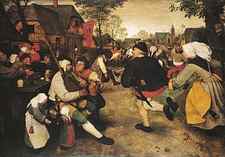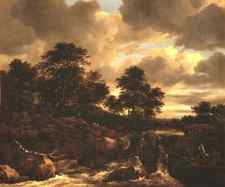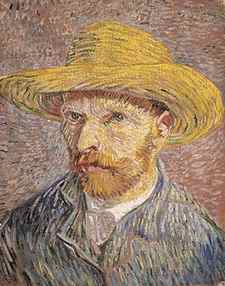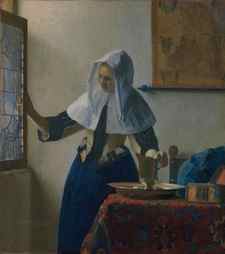Written by Steven Stokes
Kinds of subject matter
The range and interpretation of subjects in different forms of devotional painting express a particular attitude to the relationship between human beings and God. Early Christian and Buddhist murals, for example, portrayed an all-powerful, remote, and mysterious being, painted as a flat, formalized head or figure whose stern gaze dominated the interiors of temples, churches, and sanctuaries. Christian Last Judgments and Buddhist hell paintings were intended to frighten believers, while subjects such as the Virgin Enthroned, the Assumption, and Buddha descending from Paradise sustained their faith with hopes for salvation and rewards of blissful immortality.
When the autocratic ecclesiastical control over Western painting weakened under Renaissance humanism, the religious narrative picture became a window onto a terrestrial rather than celestial world. Both emotional and physical relationships between the figures depicted were realistically expressed, and the spectators were able to identify with the lifelike representation of a worldly space inhabited by Christ, his disciples, and saints, wearing updated dress and moving naturally within contemporary settings. This kind of narrative interpretation persisted in the 20th-century religious paintings of Sir Stanley Spencer, where biblical environments are represented by the clipped hedgerows, the churchyards, and the front parlours of his neat native English village of Cookham.


Allegorical narrative subjects might exalt the sensuous arts, as in the symbolic muses portrayed by Poussin and Luca Signorelli and the paradisiac gardens of 15th-century French illuminated manuscripts. But they might also carry warnings. In the 16th century, Pieter Bruegel the Elder, for example, combined overt and often grotesque symbols with subtle visual metaphors to point stern morals in such paintings as The Triumph of Death (alluding to the “wages of sin”), The Land of Cockaigne (attacking gluttony and sloth), and Mad Meg (ridiculing covetousness). Even Bruegel’s apparently straightforward genre subjects, such as The Peasant Dance and the festival of The Fight Between Carnival and Lent, conceal parables on human folly and sin, while Hieronymus Bosch introduced abstruse, allegorical phantasmagoria into such traditional narratives as The Temptation of St. Antony and The Prodigal Son and made his Garden of Delights an expression of disgust rather than of joy. Botticelli’s late paintings, probably produced under the influence of the 15th-century Italian monk and reformer Girolamo Savonarola, are other savagely pessimistic allegories: The Story of Virginia Romana and The Tragedy of Lucretia, representing virtue upheld only by death, and The Calumny of Apelles, in which envy, suspicion, deceit, guile, repentance, and truth are identified, like medieval mummers, by their costume, pose, and gesture. Rubens, however, found in allegorical symbolism a means of dramatizing mundane state commissions, such as The Union of Scotland and Ireland and The Bounty of James I (Triumphing over Avarice). Among famous 19th-century allegories are Delacroix’s Liberty Leading the People and Pierre-Paul Prud’hon’s Crime Pursued by Vengeance and Justice.

Possibly the highest achievements in narrative illustrations to poetry and literature are found in Eastern miniatures and Asian scrolls, such as the Persian paintings of Ferdowsī’s 11th-century national epic poem, the Shāh-nāmeh, and the 12th-century Japanese scrolls of the Genji monogatari and the Story of Ben Dainagon. An example of 20th-century literary painting is Sir Sidney Nolan’s narrative series portraying the Australian folklore hero Ned Kelly.
Ancient Greek and Roman mythologies have provided Western artists with rich sources of imagery and subject matter and with opportunities for painting the nude. Historical narrative painting includes Classical mythology and heroic legend, as well as the representation of contemporary events; examples include Benjamin West’s Death of Wolfe, Théodore Géricault’s Raft of the Medusa, and Goya’s The 3rd of May in Madrid.
Portraiture

The earliest surviving portraits of particular persons are probably the serene, idealized faces painted on the front and inside surfaces of dynastic Egyptian sarcophagi. The human individuality of the Roman mummy portraits of the 1st and 2nd century ce , however, suggests more authentic likenesses. Although portraits are among the highest achievements in painting, the subject poses special problems for the artist commissioned to paint a notable contemporary. The portraits of patrons by artists such as Raphael, Rubens, Hyacinthe Rigaud, Antoine-Jean Gros, Jacques-Louis David, and Sir Thomas Lawrence were required to express nobility, grace, and authority, just as the sultans and rajahs portrayed on frontispieces to Persian and Indian illuminated books and albums had understandably to be flattered as benevolent despots. Such concessions to the sitter’s vanity and social position seem to have been disregarded, however, in the convincing likenesses by more objective realists such as Robert Campin, Dürer, Jan van Eyck, Velázquez, Goya, and Gustave Courbet. Probably the finest are the self-portraits and studies of ordinary people by Rembrandt and van Gogh, where psychological insight, emotional empathy, and aesthetic values are fused. A more decorative approach to the subject is seen in the flattened portraits by Holbein, the Elizabethan and itinerant American limners, and the East Asian paintings of ancestors, poets, priests, and emperors. Like these paintings, the full-length portraits by Boucher, Gainsborough, Kees van Dongen, and Matisse display as much regard for the texture and form of their sitters’ dress as for their facial features.
Photography changed the practice of portraiture in painting for much of the 20th century, except where artists such as Cézanne and Braque used it as a subject for structural research or—like Amedeo Modigliani, Chaim Soutine, and Francis Bacon—for the expression of a personal vision beyond the scope of the camera. In roughly the last third of the 20th century, however, a number of painters, including Lucian Freud, Leon Kossoff, Francesco Clemente, Chuck Close, and Alex Katz, again took up portraiture. The commissioned portrait became rather standardized by the 21st century, but the thoughtful and majestic portraits of American first lady Michelle Obama and Pres. Barack Obama by Amy Sherald and Kehinde Wiley, respectively, two artists known for their portraits of African Americans, were widely praised in 2018 when they were unveiled at the National Portrait Gallery in Washington, D.C.
Genre

Genre subjects are scenes from everyday life. Hunting expeditions and rituals figure in prehistoric rock paintings. Domestic and agricultural occupations, with banquet scenes of feasting, dancing, and music, were traditional subjects for ancient Egyptian tomb murals. East Asian hand scrolls, albums, and screens brilliantly describe court ceremonies, the bustle of towns, and the hardships of the countryside. The depiction of earthly pursuits was forbidden under the strict iconography prescribed by the early Christian Church, but the later illuminated Books of Hours provide enchanting records of the festivals and occupations of northern European communities. In Renaissance painting, genre subjects were generally restricted to background features of portraits and historical narratives. Domestic scenes, however, not only provided Bruegel with subjects for moral allegories but, as with Rembrandt, were used to counterpoint the emotional intensity of a dramatic religious theme. The withdrawal of religious patronage in northern Europe directed painters toward secular subjects. The rich period of genre painting in the 17th-century Netherlands is represented by the interiors, conversation pieces, and scenes of work and play by David Teniers the Younger, Frans Hals, Jan Steen, Judith Leyster, Gerard Terborch, Pieter de Hooch, Adriaen van Ostade, and, the finest, by Johannes Vermeer. Pictures of rustic life had a special appeal for collectors in 18th-century France and England; these were the somewhat picturesque representations of peasant life painted by Jean-Baptiste Greuze, Boucher, George Morland, and Gainsborough. Jean-Baptiste-Siméon Chardin’s paintings of servants and children, however, exhibit a timeless dignity and grandeur. The harsher realities of working life were depicted by Jean-François Millet, Daumier, Courbet, van Gogh, and Degas; the robust gaiety of cafés and music halls was captured by Toulouse-Lautrec, John Sloan, Everett Shinn, and Walter Richard Sickert; and intimate domestic scenes were recorded by Bonnard and Vuillard. Genre movements from the 20th century included the American Scene painters, the Ashcan and Kitchen Sink schools (represented by such painters as George Wesley Bellows, Jack Smith, and Derrick Greaves), the Camden Town and Euston Road groups (Frederick Spencer Gore, Sir William Coldstream, and Victor Pasmore), and the Social Realists in England and in the United States (Robert Henri, Stuart Davis, and Maurice Prendergast). The trials and the vibrancy of African Americans were expressed by Archibald Motley, Jacob Lawrence, Horace Pippin, Faith Ringgold, and Kerry James Marshall, the latter two of whom continued to be influential in the 21st century.
Canvas Print Subject Matter
Canvas printing is a versatile production method that opens the doors to practically any image. The type of subject matter you can find can be split into two different sections, giving you plenty to think about.
Canvas printing enables you to hang just about any image on your walls, but there are a couple of different types of artwork that can work for this.
- Photography: Photography is a very popular choice for those who want to hang artwork on their walls. You can license other people’s photos or even take your own for this, giving you countless options.
- Paintings: Paintings are quite expensive, but you can achieve the look you’re going for. You can find a lot of options for painting prints available around the web.
- Digital Work: Digital artwork has been popular for a long time, especially with the rise of NFTs. You can have work like this printed to hang on your walls.
The Subject
The subject itself is possibly the most important aspect of your canvas prints. There are a lot of different subject options to choose from, and we’ve gathered a handful of them below to give you an idea of what you’re looking for.
- Portraits: People have long been one of the most popular subjects of art across the globe. Even before modern photography, painted portraits were a popular option and hung around homes, businesses, and more. Portraits can have one or more people in them, but the focal point of a portrait is the person or people.
- Natural Landscapes: Natural landscapes present an excellent opportunity for artwork, offering a challenge to artists and photographers alike. Images featuring natural landscapes can be breathtaking, making them stand out in your home or office. Ultra panoramic prints can be the perfect option for capturing and displaying your favourite natural landscape.
- Cityscapes: Similar to natural landscapes, cityscapes make spaces feel modern. Choosing a cityscape is a good way to make your canvas prints more meaningful to you. Whether you choose the city you live in, your favourite city, or somewhere beautiful you’ve never been to, these pieces add an elegant and modern feel to the space.
- Animals & Plants: Going back to the natural world, animals and plants can also make very good subjects for artwork. Having pictures of your favourite animals, plants, or pets on your walls will make your home feel special and unique to you.
- Food & Objects: Human-made objects are another common subject for art of all kinds. Vehicles, food, and an array of other items can be made into beautiful pictures that will look amazing on your walls. Photo wall tiles also provide a great way to add pictures like this to your home.
- Abstract Art: Art doesn’t always have to reflect something in the real world, with plenty of abstract artists choosing to make pictures of things that don’t look real at all. This type of art is great for those who want to use digital designs.
The Best Canvas Print Locations
Choosing the right location for a canvas print can be a challenge. Each of the rooms in your home or workplace will have different features, and this means that they will benefit from different types of artwork. You should always choose the artwork you use based on the space that it will occupy.
Office spaces are designed for work, and this means that they need to be designed and decorated with this in mind. This isn’t always easy, and you may need to experiment with the artwork that you choose. Pictures that don’t cause distractions while also calming those around them are best for this, with options like natural landscapes and abstract artwork often being ideal.
> Classic Art by Subject
Classic art is a stunning, timeless addition to any space. Shop for popular classic art canvas print subjects like abstracts, portraits, landscapes, florals, and more in the Classic Art by Subject Collection!
- Track Your OrderReturns & ExchangesShipping InformationContact Us
- About Our ProductsAbout Great Big CanvasTrade Solutions for DesignersGift Cards
- Email Us
- +1 (800) 557-2520
Copyright © 2002-2023 by Circle Graphics, Inc. Use of this web site constitutes acceptance of the Terms of Service, Privacy Policy, and Cookie Policy.
Individual images served from our catalog are copyright by their respective owners and used with permission.
GREAT BIG CANVAS is a registered trademark of Circle Graphics, Inc.
- Irises
- Wheat Field with Cypresses
- View to the Amalfi Coast
- Bordighera
- Water Lilies
- View of Vetheuil
- Battle Between the French Frigate ‘Arethuse’ and the English Frigate ‘Amelia’
- Water Lilies, 1916
- Vetheuil in Summer
- Donna con ventaglio
- Nighthawks, 1942
- Girl with a Pearl Earring
- Irises By Vincent Van Gogh
- The Artist’s Garden in Argenteuil, by Claude Monet, 1873
- Cafe Terrace, Place Du Forum, Arles, 1888
- Water Lilies
- Kleine Welten I (Small Worlds I)
- A Sunday on La Grande Jatte – 1884
- Almond Blossom
- Water Lilies
- Seascape Near Les Saintes-Maries-De-La-Mer By Vincent Van Gogh
- The Manneporte (Etretat)
- Vue ensoleille pres d’Auvers
- Jeanne Hebuterne (1898-1920)
- Garden At Arles, 1888
- American Gothic – Original Color
- Roses – The Perfection of Summer
- Poppy Field, 1890
- The Tree of Life – Stoclet F
- Forest Landscape in the Moonlight, 1861, Dutch oil painting
- The Houses of Parliament (Effect of Fog)
- American Gothic
- Colorful Architecture
- Study of a Male Nude
- Composition
- The Beach at Sainte-Adresse
- Water Lilies, c1920
- Bridge over a Pond of Water Lilies
- Flaming June By Frederic Leighton
- Sea Serpents
- Impression, Sunrise, 1872, By French impressionist Claude Monet
- Squares with Concentric Circ
- The Night Cafe, 1888
- The Nightmare, 1781
- Landscape, 1830-45, Dutch painting, oil on canvas
- Ship On Stormy Seas By Ivan Konstantinovich Aivazovsky
- St. Michael the Archangel, 1635. St Michael stepping on Devil’s head
- Detail Of The Kiss, 1907-1908





